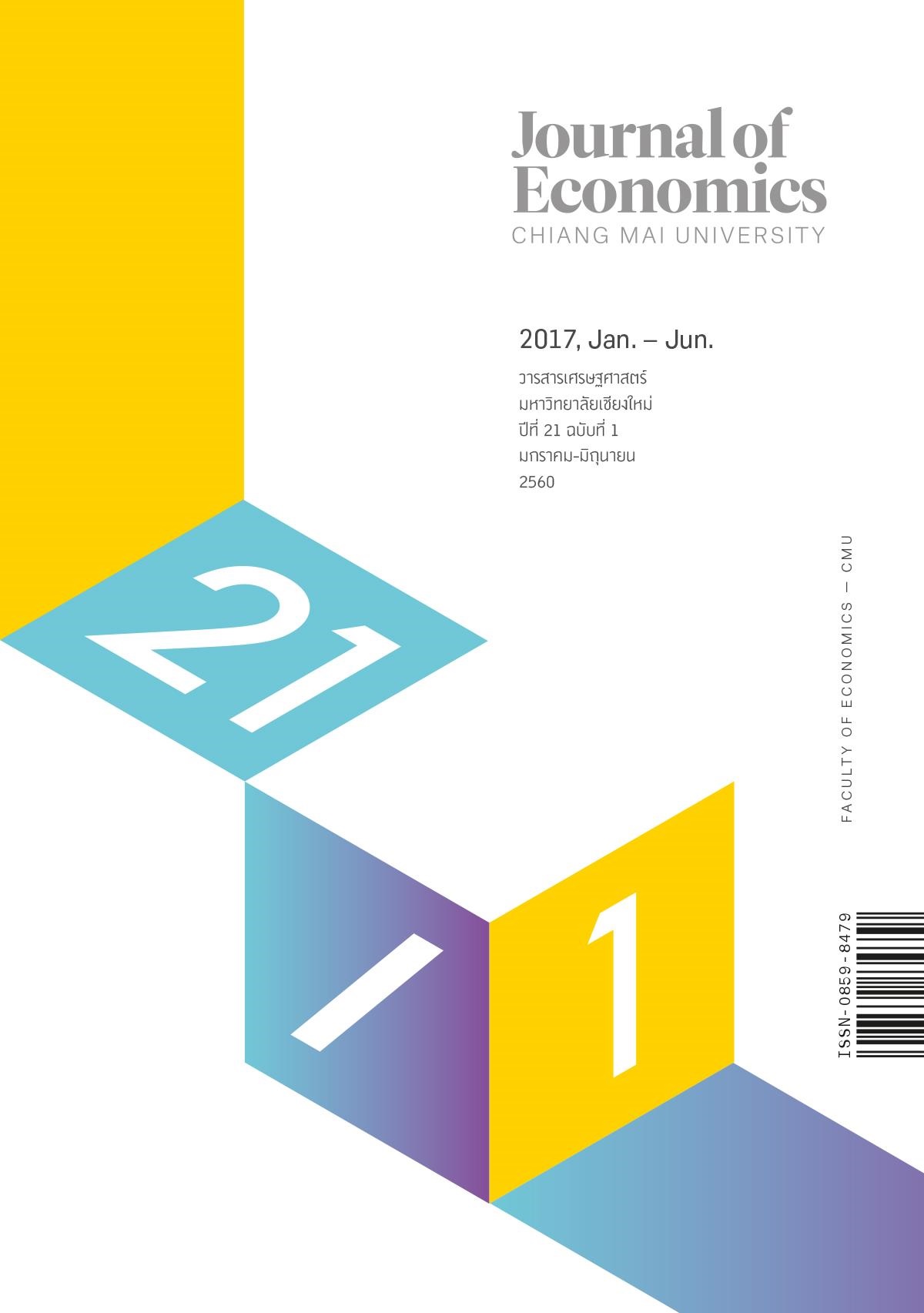แบบจำลองการถดถอยของจำนวนการถูกอ้างอิง และดัชนีผลกระทบการอ้างอิงวารสาร REGRESSION MODEL OF CITATION AND JOURNAL IMPACT FACTOR
Keywords:
แบบจำลองทางเศรษฐมิติ, การถูกอ้างอิงของบทความ, ดัชนีผลกระทบการอ้างอิงวารสาร, Citation, Econometric model, Journal Impact FactorAbstract
บทคัดย่อ
บทความวิชาการเป็นการศึกษาที่ทำการศึกษาเรื่องใดเรื่องหนึ่งแบบเฉพาะเจาะจง และวารสารวิชาการเป็นแหล่งรวบรวมบทความที่มีการศึกษารูปแบบคล้ายกันมาไว้ในวารสารเล่มหนึ่ง โดยการวัดความนิยมของบทความและวารสาร คือ บทความจะถูกวัดจากจำนวนการถูกอ้างอิง (Citation) และวารสารจะถูกวัดจากดัชนีผลกระทบการอ้างอิงวารสาร (Journal Impact Factor : JIF) การศึกษาปัจจัยทั่วไปที่ทำให้บทความและวารสารได้รับความนิยมจึงเป็นสิ่งที่น่าสนใจ บทความนี้แบ่งเป็น 2 แบบจำลอง คือแบบจำลองสำหรับบทความที่ใช้ข้อมูลจากปี 1992–2016 และแบบจำลองการอ้างอิงวารสารที่ใช้ข้อมูลจากปี 1990- 2016 จำนวน 100 ตัวอย่าง ทั้งสองแบบจำลองผลการศึกษาปัจจัยที่มีอิทธิพลต่อจำนวนการถูกอ้างอิง พบว่าจำนวนหน้า จำนวนครั้งในการดาวน์โหลด จำนวนเอกสารอ้างอิง และอายุของบทความส่งผลในทิศทางเดียวกันกับ จำนวนการถูกอ้างอิง ส่วนจำนวนผู้แต่งมีความสัมพันธ์ในทิศทางตรงข้าม และการศึกษาปัจจัยที่มีอิทธิพลต่อดัชนีผลกระทบการอ้างอิงวารสาร พบว่าจำนวนบทความทั้งหมดที่ได้รับการตีพิมพ์ในวารสารนั้น และจำนวนฉบับของวารสารทั้งหมดมีความสัมพันธ์ในทิศทางเดียวกันกับดัชนีผลกระทบการอ้างอิงวารสาร ในขณะที่จำนวนฉบับของวารสารในช่วงเวลา 1 ปีมีความสัมพันธ์ในทิศทางตรงข้าม การศึกษาในครั้งนี้สามารถใช้เป็นแนวทางในการส่งเสริมให้เกิดประโยชน์ต่อการสร้างผลงานทางวิชาการ
Abstract
An article is an academic paper that aims to study a specific subject and a journal is a collection of articles in the same academic fields. A measurement of the popularity of articles and journals are number of references (Citation) and the Journal Impact Factor (JIF) respectively. In this paper we studied two models, factor affecting citation quantity and JIF. First model, number of top 100 ranking citation index during 1992 – March 2016 of 100 articles were estimated. The second model employed top 100 JIF journals during 1990- 2016 also validated by econometric model. The results revealed that number of pages, number of downloading, number of references and age of published had positive relation to number of citation index whilst number of authors had opposite direction. For journal model, number of total volume and number of annual volume had positively and negatively affected to JIF respectively. Finally, the results from this study were beneficial guide dance to those who would like to contribute their academic works worldwide.
Downloads
Additional Files
Published
Issue
Section
License
All opinions and contents in the CMJE are the responsibility of the author(s). Chiang Mai University Journal of Economics reserves the copyright for all published materials. Papers may not be reproduced in any form without the written permission from Chiang Mai University Journal of Economics.
ข้อคิดเห็นที่ปรากฏและแสดงในเนื้อหาบทความต่างๆในวารสารเศรษฐศาสตร์มหาวิทยาลัยเชียงใหม่ ถือเป็นความเห็นและความรับผิดชอบโดยตรงของผู้เขียนบทความนั้นๆ มิใช่เป็นความเห็นและความรับผิดชอบใดๆของวารสารเศรษฐศาสตร์ มหาวิทยาลัยเชียงใหม่
บทความ เนื้อหา และข้อมูล ฯลฯ ในวารสารเศรษฐศาสตร์มหาวิทยาลัยเชียงใหม่ ถือเป็นลิขสิทธิ์เฉพาะของคณะเศรษฐศาสตร์มหาวิทยาลัยเชียงใหม่ หากบุคคลหรือหน่วยงานใดต้องการนำทั้งหมดหรือส่วนหนึ่งส่วนใดไปเผยแพร่ต่อหรือเพื่อกระทำการใดๆ จะต้องได้รับอนุญาตเป็นลายลักษณ์อักษร จากวารสารเศรษฐศาสตร์ มหาวิทยาลัยเชียงใหม่






